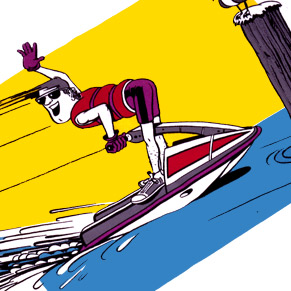Most drownings among men 18 to 34 years occur on lakes and rivers. Swimming remains the leading activity, as it is with younger age groups, but boating activities become much more prevalent, including powerboating, fishing and canoeing.
While the proportion of fatalities among 18-34-year-olds involving these risk factors are similar to earlier years, the overall reduction in deaths and fewer numbers of fatal incidents involving these behaviours suggests that some young men entering this lifestage in the past 10 years are behaving more responsibly. However, there is much room for further attitude and behavior modification, especially with regard to wearing lifejackets or PFDs (personal flotation devices).
Risk-taking behaviours extend into adult years. This includes the reckless operation of motorized vehicles and the consumption of alcohol and drugs. Many young men participate in a responsible manner with their spouses and children, but demonstrate more reckless behaviour with their male friends. Many seek activities that involve high-speed craft and do not change their behaviour in the face of inclement weather and rough water. They are unlikely to wear safety equipment such as lifejackets.
:::

Male risk-taking behaviour is exhibited in:
Drowning prevention tips
Buy yourself time: wear your lifejacket.
Most drowning victims never intend to get in the water. And trying to put a lifejacket on just before you capsize is like trying to buckle a seat belt just before you have a car crash.
Canadian waters are cold most of the time. Heavy gasping, uncontrollable hyperventilation and cold shock can occur in just the first minute of entering cold water. If the cold shock doesn't kill you, time will. But if you're wearing your lifejacket, you'll float and have a chance to survive a fall into cold water.
If you drink, don't drive your boat.
Ironically, the same people who would never drink and drive their car will drink and boat. In Ontario, if you are convicted of driving a boat while under the influence, you will lose your license to operate your boat and your car.
Be prepared. Get trained.
Coast Guard reports most calls for help are predictable and preventable non-distress calls; boats broken down, run aground or out of gas. Have a proper checklist for your boat and review it before you head out. Make sure that your boat is mechanically sound and that you have enough gas for your intended trip. File a float plan to help Search and Rescue find you in the event of a real emergency.
All operators of recreational powered craft are required to obtain a Pleasure Craft Operator Card. This requires passing a written test demonstrating knowledge of the basics of boating safety including the rules of the road on the water.
Check the ice before you go on it.
Clear, hard, new ice is the only kind of ice recommended for travel. Avoid slushy ice, ice on moving water (rivers, currents), or ice that has thawed and refrozen. Keep away from unfamiliar paths, unknown ice and avoid travelling on ice at night. Remember, ice quality and thickness varies across a body of water and both can change very quickly.
Wear a thermal protection buoyant suit to increase your chance of survival if you go through.
Dog walkers need to be careful. Year after year, owners drown trying to rescue their dogs.